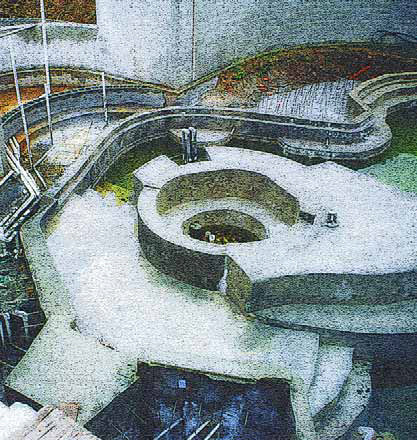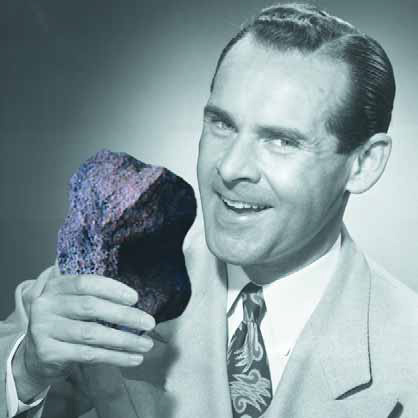Natural stone is certainly beautiful, says watershaper Paolo Benedetti, but sustaining that beauty often means taking steps in the installation process to ensure easy maintenance and enduring protection of the stone's exposed surfaces. Here, in the first of a series on enhancing the appearance and durability of hardscape materials found around watershapes, he takes a look at the family of chemicals designed to seal in the splendor of stone.
Water moving in all sorts of different directions (but always in controlled ways) is a hallmark of one our favorite designers, architect David Tardiff. We've built the watershapes for many of his projects, and we've particularly enjoyed those that put both his vigor and special subtlety on display. Time and again, his designs have challenged us technically while rewarding our clients with results that always seem to leave them proud, amazed and thoroughly satisfied. As we've discussed in our previous WaterShapes articles, a large part of our business is about executing watershapes for architects and landscape architects in the backyards of mostly affluent clients in southern California's Orange County. Each designer has his or her own creative style and sensibility, leaving us to adapt the work we do to their "idea sets" while lending our years of practical experience in engineering and construction to the process. In working this way, we find that everyone comes out a winner: The designer creates work that is based in reality; we stretch and expand our skills to realize truly spectacular design concepts; and most important, clients gain refined spaces that hit the mark with respect to both functionality and aesthetics. The two projects we'll visit on these pages are
Finding ways to blend the angular rhythms of modern architecture with the sweeping splendors of nature constitutes one of the more difficult challenges faced by today's watershapers. In the case of the project pictured on these pages, we were contacted in 2002 about an enormous, modern-style home on Mercer Island overlooking the shore of Lake Washington, right near Seattle. The property was being remodeled, and the owners wanted a set of watershapes that would enhance the beauty of the two-acre estate while more convincingly integrating the geometry of the structure with its woodsy lakefront setting. The solution: a set of watershapes that start near the house with perfect geometric forms that stick to the architect's original design, then moves down the hillside through various transitional stages to a pond feature that looks like part of
This column must be prefaced with the thought that, for a great many of our clients, perception is reality. That's something I hold onto whenever I get involved in trying to understand and use feng shui, the ancient Chinese method for arranging harmonious, balanced spaces. I am far from a devotee of the art (or science, as some would have it), but I'm aware that some of my clients know a thing or two about it - and that knowing something myself is essential to working with them successfully or at all. There are literally hundreds of books about feng shui. Of the half dozen I've read, none is better suited to the needs of the watershaper than The Complete Illustrated Guide to Feng Shui for Gardens by Lillian Too (Element, 1999). There are a couple of key points that make Too's perspective on feng shui so useful: First, she
The project I've been working on in the hills outside Hanover, Pa., has just about every feature, bell and whistle one can imagine. That inclusiveness of detail at every level has translated to an unusually intricate construction process, as I mentioned last time in discussing the excavation, forming, plumbing and steel phases. Now we get to the gunite. Where a garden-variety backyard pool involves placement of maybe 30 to 50 yards of concrete and some larger projects may run in the 50-to-70-yard range (and where most of mine tend to fall in the 90-to-130 yard range) - this project needed two gunite rigs shooting for two solid days, 12 to 13 hours each day. The pool shell alone (excluding the waterfall, the grotto and several other features we'll get into later) required a staggering 300 yards of concrete. That's about
Rocks are, in my opinion, among the most versatile of all elements that can be added to landscape designs. As was discussed in my last column, they can be used to add texture or dimension or retain soil; they can also be used to add background or hide eyesores, and there are myriad other uses creative designers can find for them. Of course, different design styles call for different uses of rocks, stones and pebbles. An Asian garden, for example, might use them to simulate or represent water or mountains in a landscape, while the very same stones used in a cottage or natural setting might serve no purpose beyond providing a place to sit or a focal point that
Last month, I jumped into the New Year with a discussion of how the trends we face these days are influencing our recent experiences in business, society and life in general. In doing so, we navigated our through a mixed bag of factors - advancing technology, interesting economic times and complex legal conditions on the grand scale up alongside local, narrower issues having to do with the emergence of the watershaping business, the wayward nature of trade associations and the state of relevant education for our trades. All that was intended to set up this column's discussion of where we, as the watershaping industry, might be going in the months and years to come. Pure prognostication, however, is an imperfect process in which I won't indulge. Rather than get into the aimless game of offering predictions, I'll delve instead into
Sometimes I like clichés. That's tough and perhaps treasonous for an editor to admit, but there are certain phrases that truly resonate, and I stand by them for what I think are





















